The Demand for Smart and Efficient Conveying Systems
Conveyor technology ranges from basic to smart with the ability to handle complex packaging systems.
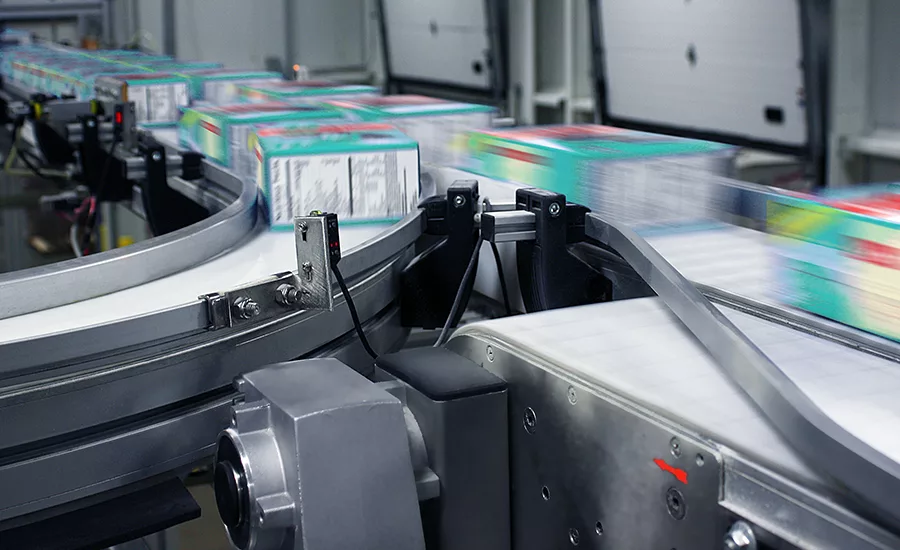
Customized modern-day automated high-speed packaging line conveyor designs, like this one engineered by NCC Automated Systems, feature lane switching and merging to speed up product flow and be able to switch product size and SKUs easily. Image courtesy of NCC Automated Systems
Whether upgrades, retrofits or new installations, conveying systems need to fit in with existing automation systems, use less energy and be even smarter than ever—with the ability to accommodate changing product or packaging sizes in a single shift. At the same time, cleanliness to FDA, USDA and dairy 3-A Sanitary Standards is a must. Many conveying projects are application-specific and often require design work. Unfortunately, supply chain and labor issues can delay custom-designed projects significantly, so adequate planning and scheduling is required.
According to a recent survey, “Conveyor System Market by Industry” from Research and Markets, the global conveyor system market size is projected to reach $12.7 billion by 2027, from an estimated value of $9.4 billion in 2022, a CAGR of 6%. The key driving factors are higher adoption of customized automated material handling solutions based upon niche specifications in various end-use industries and rising demand for handling larger volumes of goods, especially in consumer/retail, food and beverage markets.
According to the report, the constant investments in R&D by conveyor system manufacturers accompanied with growing supply chain networks is fueling the demand for conveyor solutions in the forecast period. According to the UN Industrial Development Organization, the consumption of goods in developed countries is expected to rise to approximately $30 trillion by 2025. This rise is expected to increase the penetration of industrial automation and the requirement for efficient material handling systems.
While certain specialized applications in the food industry—such as bulk and dry products—often involve enclosed tubular conveyor systems (e.g., vacuum, drag, etc.), the study shows that, by type, the belt conveyor is projected to be the largest and one of the fastest growing markets. Belt conveyors can handle higher capacities at significantly lower cost per ton-kilometer and cover longer distances more easily and economically than other conveyors. Though many food and beverage applications specifically depend upon sealed tubular conveyors to minimize dust and preserve cleanliness, the study says that belt conveyors work alongside specialized conveyance systems in food and beverage, especially in packaging and warehousing/distribution systems.
Trends in Food and Beverage Conveyance Systems
No matter the type of conveyor, cleanliness is a major driving factor in our industry. “Ever-changing sanitation requirements remain the key topic of discussion for food and beverage manufacturers,” says Multi-Conveyor’s Cheryl Miller, director of marketing. This means a greater demand for stainless steel constructed systems built to strict sanitation guidelines as mandated by the FDA, USDA or dairy agencies—to name a few. Compliance may require washdown bolted designs, wear-strips and continuous welds, sanitary supports, pattern cleanout holes, stainless steel frames and special-rated power transmission components—and 3-A Sanitary Standards require actual certification.
ASGCO Complete Conveyor Solutions provides belting, idlers, primary and secondary belt cleaners, dust control and skirting products, and more, plus it offers maintenance and repair services, belt splicing and laser scanning. According to Ryan Chatman, marketing manager, food processing clients are needing anti-microbial conveyor belting and capped-edge belting to help prevent food contamination.
For conventional belt conveyors, an edge-driven belt may make sense for a couple of reasons. (See FE’s Engineering R&D, June 9, 2021.) FE had interviewed Kevin Mauger, president of SideDrive Conveyor Company. When asked why a company would choose an edge-driven conveyor, Mauger suggested that the conveyor can be driven at multiple points, keeping belt tension even throughout. In addition, without a rotating drum or cage, the conveyor is easier to clean, which helps reduce the risk of food contamination.
However, a self-contained drum roller/motor driving a belt conveyor has several advantages over conventional gear housings and motors, especially in sanitation. Alexander Kanaris, president of Van der Graaf, pointed out a few in a FE Engineering R&D interview some years ago. Having no gear box and external motor takes away places for bacterial harborage, as the motor and gears are internal and sealed within the roller drum. Changes over time have also improved the rating of these assemblies to IP69K, allowing for washdowns with harsh chemicals. Drum assemblies can accommodate standard belting and thermoplastic belts with a sprocket system, which allows indexing for position control.
Top 5 Tips to Optimize Product Flow in a Packaging Line
- Work hard to understand how the equipment functions together as a system. Design the line controls so that the equipment specifics work with each other as a harmonious system.
- Consider the layout from an operator, mechanic, sanitation and materials supply perspective.
- Put yourself in the eyes of the product. Consider all factors affecting the product along its journey—transfers, guiding mechanism, conveyor medium and “what happens if” with various scenarios played out.
- Consider the future. What type of additional capacity or flexibility will you need?
- Develop a clear training plan for your staff, considering both operation and maintenance.
— Kevin Mauger, President NCC Automated Systems
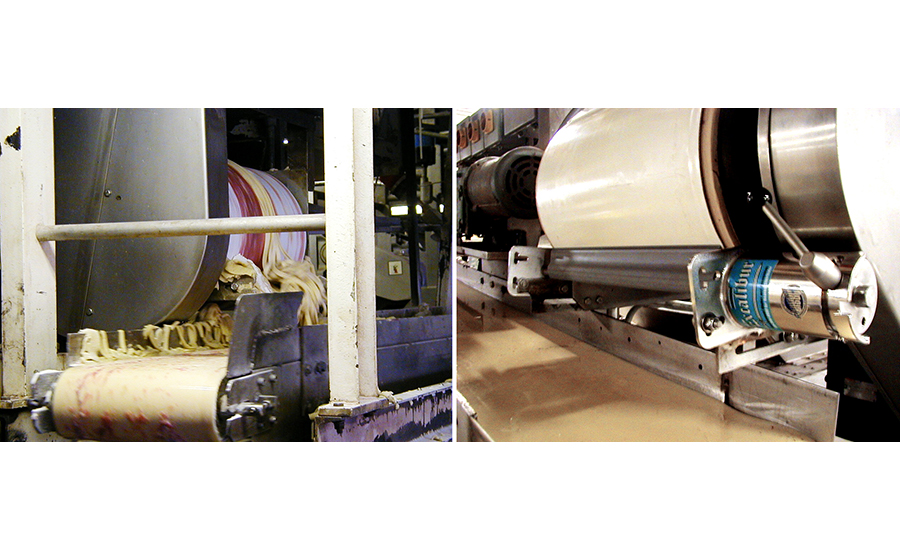 ASGCO’s Excalibur food grade belt cleaning system scrapes sticky dough off this conveyor belt before it has a chance to travel any farther, causing the belt to skew or entering bearings or other parts. The device can be used with other sticky substances such as chocolate or proteins.Photo courtesy of ASGCO
ASGCO’s Excalibur food grade belt cleaning system scrapes sticky dough off this conveyor belt before it has a chance to travel any farther, causing the belt to skew or entering bearings or other parts. The device can be used with other sticky substances such as chocolate or proteins.Photo courtesy of ASGCO
Today, cleaning and keeping downtime to a minimum is a big deal, and clean-in-place (CIP) is becoming more of a necessity than a nice-to-have. Rick Leroux, VP and general manager of Luxme International, Ltd. (maker of tubular chain conveyors), sees increased interest in conveyors designed with CIP capabilities. In addition, conveyors are often equipped with product-contact part cleaning components to extend intervals between cleaning cycles. Therefore, the equipment runs cleaner and longer. The takeaway is that the more time between multiple, dry cleans prior to a wet wash means increasing production line uptime/productivity, says Leroux.
One example of a belt cleaning tool is ASGCO’s Excalibur food grade belt cleaning system, which was installed at a Midwest bakery. When mounted on a belt conveyor, the stainless steel (SS) device prevents dough carry-back. In the bakery, without the device installed, the carry-back dough would not release from the belt, build up on the belt surface and work its way into the return rollers, causing the belt to mis-track and sustain edge damage.
Cablevey, maker of tubular drag conveyors, has seen an increase in interest from food and beverage processors in moving bulk ingredients and frozen foods, says Clint Hudson, sales engineering director. The advantage of using tubular conveyors for dry bulk products is that it keeps dust to a minimum, keeping the space around them clean as well. Hudson says there has been increased interest in the company’s Clearview tubing because processors can see the behavior of the product inside and they can visually inspect the cleanliness of their conveyor.
In packaging areas, concerns over sanitation are as important as in the production areas, says Leroux. For example, he lists some key points:
- Batch-to-batch cross-contamination can be better managed with the use of dry or wet wash features built into the conveyors.
- Dry cleaning is being practiced more often as air-knife cleaning technology, vibration technology and internal surface wiping components are included with food handling conveyors. Brushes are avoided because of the risk of the bristles releasing and causing food contamination. The bases of the brushes harbor accumulated contaminants/bacteria that build up over time and are difficult to remove. Their release into the conveyor can cause a significant contamination event.
- Sanitation levels are being measured and monitored more frequently and to a higher level to comply with increasing food production sanitation standards.
- Wet cleaning practices require food conveyors to handle water and use materials that are not compromised by cleaning chemical acid or caustic levels.
- CIP-designed conveyor systems must include fast-dry solutions to get processing and packaging lines up and running with minimal downtime.
- USDA-certified design levels are needed to ensure thorough clean-out of bacteria and allergens at each wet wash cycle for packaging and RTE transfers.
Leroux also notes that processors are concerned with energy. They would rather see 20-hp powered systems rather than 200 hp. Food manufacturers are also looking for low mechanical noise systems and equipment that meets a facility’s clean-air specifications.
Off-the-Shelf or Custom?
For new plants, it may be easy to specify modular conveying equipment and put it together into a system. But when it’s time to upgrade or replace existing machinery, custom designs may be a necessity, and most conveyor companies can accommodate “bespoke” systems. Of course, a potential problem with customized equipment is the availability of materials and labor, which some suppliers are still reporting as issues in planning realistic project completion dates.
“The vast majority of what we sell is modular components that are engineered to fit a wide spectrum of customer needs,” says Cablevey’s Hudson. “However, there are customers with very specific requirements that our components can’t satisfy. Our engineering department provides design services to fill those specific needs. Custom-designed components take a bit longer to get to the customer than one of our off-the-shelf items, but the lead times are generally acceptable.”
Most conveyor needs are met by custom-built systems specific to a plant or factory. ASGCO offers a full range of design and engineering services,” says Chatman. With its extensive range of partners, ASGCO has been able to significantly cut down on supply chain issues and deliver products and services on time.
“Unforeseen challenges within all markets—not just food and beverage—is the trickledown effect of the supply chain meltdown and pandemic-induced labor shortages,” says Multi-Conveyor’s Miller. “Those two anomalies have caused an increase in demand for finished goods—which translates to ‘we need something and we need it yesterday.’ The packaging industry has ordered equipment for years based on an approximate two month build time. The current global state of manufacturing will not be out of peril anytime soon. Planning much further in advance for plant expansion equipment, knowing deliveries will far exceed the norm, must be on the forefront of all CPGs.
“We do, however, also offer two pre-engineered, standard conveyors available for a more prompt delivery,” adds Miller. The Success line offers standard, simplistic, non-washdown straight running chain. The processor chooses from predetermined widths and curves—with lengths options. Multi-Conveyor also offers its Slim-Fit low profile sanitary washdown systems in pre-engineered lengths and widths. They, too, although in a higher demand, are still more readily available versus a custom conveyor solution, says Miller.
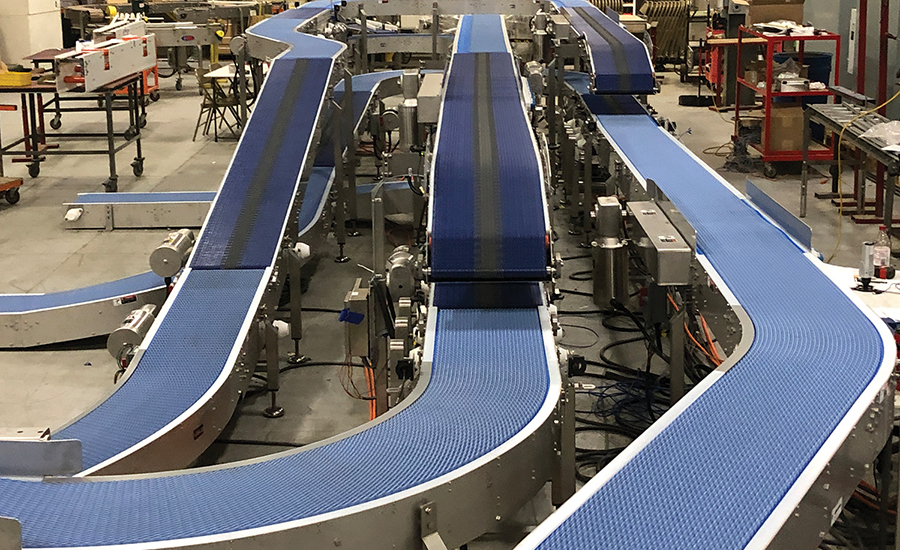
Over-under transpositor merges three-baggers to two case-packers.
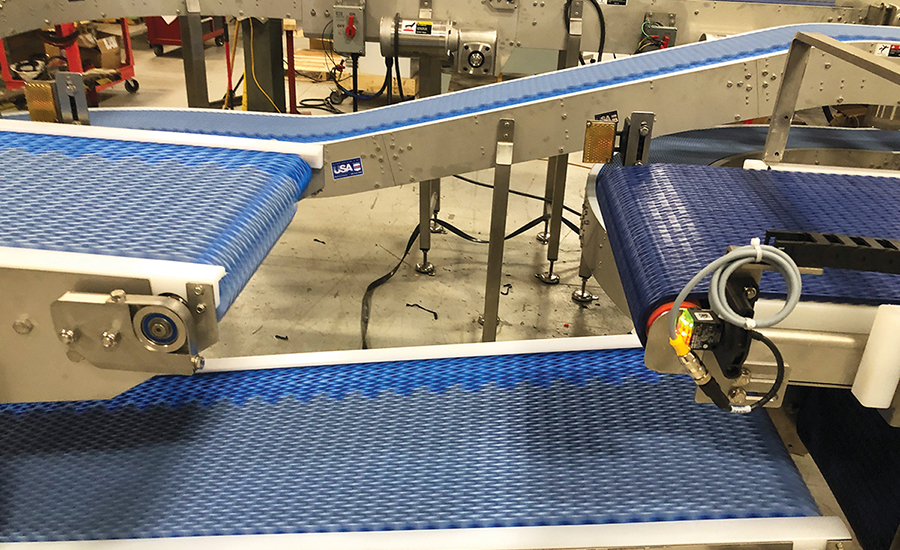
Over-under transpositor product-settling merge—three baggers to two case-packers.
Photos courtesy of Multi-Conveyor
Challenges in Conveyor Package Handling Systems
Multi-Conveyor recently installed a system to handle bagged, frozen chicken. As is the case with most modern designs, flexibility is key to keep product moving. Challenges in this application included:
- Multitude of product sizes, weights and rates
- Vibratory bag settling sections in some conveyors to distribute product within the bags
- Merging and balancing of three lanes to two lanes
- Very limited floor space
- A three-foot elevation differential from the baggers to X-ray systems, which was complicated by the additional elevation changes needed for the servo transpositor and servo over/under merges and related alternate conveyor paths
- Electrical expertise in PLCs, VFDs and servo motors
Some products require only two baggers and deliver product to the two lanes going directly to the X-ray systems. If one bagger goes down, product is transferred to the third bagger and delivered to the transpositor that will then be positioned to deliver bags to the alternate conveyor path for the now-empty lane of the down bagger.
Some product rates require three baggers to meet the required throughput. The third bagger delivers product to the transpositor, which will evenly distribute bags between the two upper-level alternate bagger lane conveyors. The third bagger flow then goes to its respective over/under servo merge on each lane. The servo belts on the lower-level position product to allow the bags from the upper level to drop in to an opening created by the servo belts.
The Multi-Conveyor controls and conveyors for the bag handling are part of its larger overall system that also includes full case indexing and merging from the two case packing lanes to a single discharge flow to a metal detector, overhead roller conveyor, and then to the processor’s palletizing line. The bag and case system is PLC controlled and includes more than three-dozen VFDs and a multitude of servos.
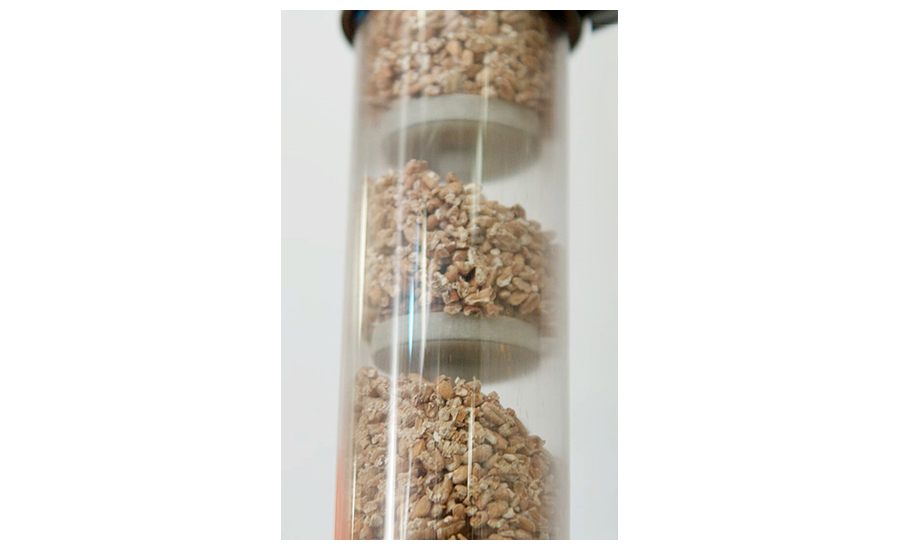 The vast majority of what Cablevey sells are modular components that are engineered to fit a wide spectrum of customer needs.Image courtesy of Cablevey
The vast majority of what Cablevey sells are modular components that are engineered to fit a wide spectrum of customer needs.Image courtesy of Cablevey
Planning for large material handling systems often involves more than just locating or force-fitting conveyors in a layout. In addition to meeting a plant’s physical specifications, a conveyor needs to meet electrical codes, have compatible materials and be specified for corrosion, service duty, abrasion, sanitation and material transfer integrity, says Leroux. A custom engineered conveyor is typically a better product and built to deliver higher long-term value to processors because it was designed specifically to meet application needs.
“Smart Conveyors” Are in More Demand
The application of “smart conveyers” really is determined by what food processors expect in a certain application. Discharging a supersack of a powder or granular substance into a vessel may not require more than an off/on function from a weigh-scale. However, automation is a big factor in increasing the efficiency of conveyor systems, says Chatman. The driver for automation is ultimately increasing the quality of finished goods and the speed of the system.
Multi-Conveyor uses technology-driven operator-to-controls communications encompassing functional engineering designs. “We use HMI interfaces and servos that provide faster, more efficient changeovers to feed various line packaging, case packing and pallet forming configurations,” says Miller. “Flexibility in product shapes, weights and sizes are matched for increased throughput and future expansion.” However, she reminds us that automation in conveyors is only as good as the controls that allow the OEM systems on the production line to “talk” to one another through standard communications systems.
While smart conveyors are available from multiple vendors, they haven’t reached a high level of adoption due to the capital cost premium to adopt smart components and the associated control packages that are needed to use the data collected from the conveyor, says Leroux.
However, he says that major drivers in the food industry for making conveyors smarter are the need for traceability and cleaning process validation with sanitary CIP applications on post-kill point, RTE or transfers to packaging.
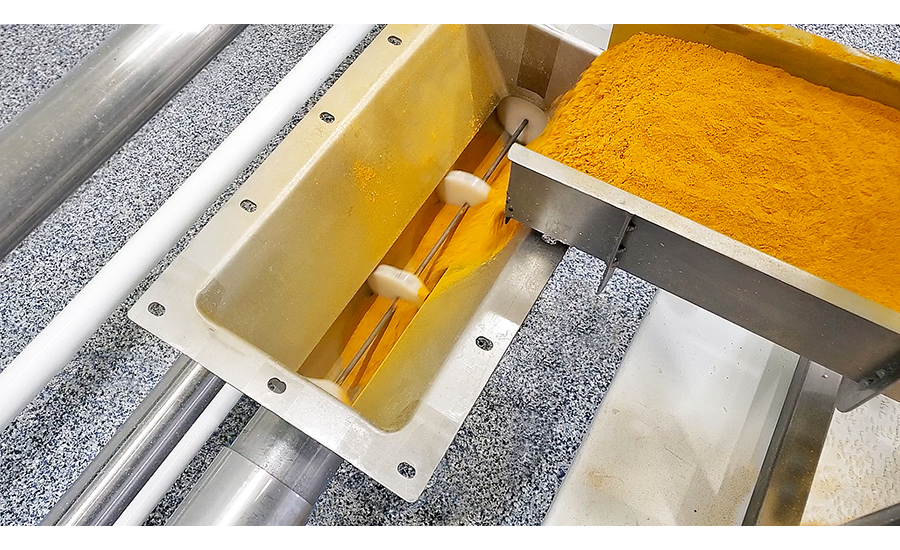 Much of the conveyor automation that Cablevey customers are seeking concerns communicating the needs of upstream and downstream components to speed up, slow down, or stop the conveyor. Shown here is the conveying of turmeric powder.Image courtesy of Cablevey
Much of the conveyor automation that Cablevey customers are seeking concerns communicating the needs of upstream and downstream components to speed up, slow down, or stop the conveyor. Shown here is the conveying of turmeric powder.Image courtesy of Cablevey
As part of the cleaning program, smart conveyors need to register batch SKU and associate that SKU with the sanitary cleaning cycle’s water temperatures, soak times, spray jet pressure, water temperature, and cleaning solution conductivity for each of the caustic, acid and sanitizer wet cleaning stages. Sensors also monitor air temperature and drying time of the hot, forced air drying stage, says Leroux.
Providing validation of a consistently repetitive and thoroughly executed sanitary cleaning cycle can be used to confirm the absence of variability in a proven sanitary washdown process. Smart CIP monitoring alerts operators and can abort/interrupt a cleaning cycle if a cleaning parameter is not within the parameters and protocol specified by the food producer. This control can save food producers from processing off-grade batches that need to be rejected. It lowers the risk of product recalls by preventing improperly cleaned equipment from releasing bacterial or and allergens into the final product prior to packaging.
Resources:
“Smart conveyors enable gentle handling and high throughput in ready meal production,” FE, October 12, 2021
“Sanitary Conveyor Boosts Food Safety and OEE for Nutrition Bar Maker,” FE, Aug. 11, 2022
Looking for a reprint of this article?
From high-res PDFs to custom plaques, order your copy today!








